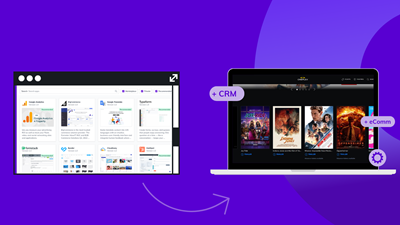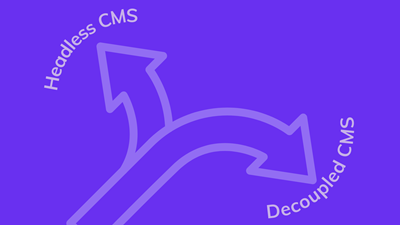Exploring the Power and Benefits of Composable CMS.


Amongst the whirlwind of ever-emerging buzzwords, ‘composable CMS’ has popped up as a new standard in content management. While these tools themselves are nothing new, this term acts as a differentiator in the market for decision-makers looking to upgrade their tech stack.
What is a Composable CMS?
A composable CMS is a content management system that allows organizations to create and manage digital experiences by combining independent, interchangeable components, often referred to as "composable building blocks," which can include content modules, microservices, APIs, widgets, and more.
Benefits of Composable CMS:
- Flexibility: Composable CMS empowers organizations to adapt and respond to rapidly changing business needs. Instead of having to replace an entire vendor/system, as with monolithic architecture, a composable CMS allows businesses to add, remove, or replace components. This architecture is the foundation of a successful stack for organizations looking to maintain a competitive edge and enables faster time-to-market.
- Cost Efficiency: Composable CMS offers cost efficiency by eliminating the need for extensive customization or redevelopment. Instead of investing in a complete overhaul of the CMS, businesses can simply add or replace specific components to meet evolving needs.
- Vendor-Agnostic Flexibility: Composable CMS provides vendor-agnostic flexibility, allowing organizations to leverage the best-in-class tools and services for each component. Businesses can choose the most suitable solutions for their requirements and integrate them seamlessly into their composable CMS.
Distinguishing True Composable CMS:
As with any popular trend, there are CMS platforms that claim to be composable but may fall short of delivering the promised benefits. To distinguish true composable CMS from the rest, consider the following factors:
Modularity:
A genuine composable CMS should offer a truly modular architecture, allowing you to develop and deploy components independently. Ensure the CMS provides granular control over each module, enabling seamless customization and replacement.
When evaluating a composable CMS for true modularity, consider the following aspects:
- Component Independence: The CMS should allow each component to operate independently.
- Reusability: Look for a composable CMS that promotes component reusability. Each module should be designed and structured to allow it to be easily reused across different projects or digital experiences.
- Granular Control: The CMS should provide granular control over each module or component. This includes managing, configuring, and updating components individually without affecting the entire system.
- Interoperability: True composable CMS platforms prioritize interoperability by offering well-defined APIs and integration capabilities. Connecting and exchanging data with external systems ensures a seamless flow of information across the entire digital ecosystem.
MACH Alliance Membership:
Look for CMS platforms that are members of the MACH Alliance. MACH stands for Microservices-based, API-first, Cloud-native, and Headless. Being a member of this alliance indicates that the CMS adheres to the principles of a composable architecture and the use of modular, interoperable, and scalable components.
API-First Design:
An API-first approach is a key characteristic of a composable CMS. It should offer well-defined APIs that enable seamless integration with external systems and services. APIs allow for the smooth exchange of data and functionalities, facilitating the composition of different components and services into a unified digital experience.
To determine if a CMS is API-first, consider the following indicators:
- Documentation and Emphasis on APIs: An API-first CMS will have comprehensive documentation and resources dedicated to its APIs. The documentation should provide clear instructions on how to use the APIs, including authentication, endpoints, request/response formats, and available functionalities. The CMS provider should also emphasize the importance of APIs in their marketing materials and highlight their capabilities.
- Robust API Capabilities: An API-first CMS will offer a wide range of APIs covering various content management and delivery aspects. Look for APIs that allow you to create, update, retrieve, and delete content and manage users, permissions, and settings. The CMS should provide APIs for content delivery, allowing you to retrieve content for different channels and devices.
- Developer Support: An API-first CMS will prioritize developer support and provide resources to facilitate API integration. Look for developer documentation, SDKs (Software Development Kits), code samples, and community forums where developers can seek assistance and share knowledge. Regular updates and improvements to the API ecosystem also indicate a commitment to an API-first approach.
- Headless CMS Capabilities: API-first CMS platforms often go hand in hand with headless CMS architectures. A headless CMS decouples the content management backend from the presentation layer, allowing you to deliver content through APIs to various front-end channels. If the CMS emphasizes headless capabilities and supports a variety of front-end frameworks and technologies, it is likely to be API-first.
- Integration and Extensibility: An API-first CMS will prioritize integration and extensibility. It should provide seamless integration options with third-party services, systems, and tools through its APIs. Additionally, an API-first CMS will support custom extensions and integrations, allowing developers to extend the CMS's functionality through their own APIs.
- Cloud-Native Architecture: A composable CMS should be built on a cloud-native architecture, leveraging the benefits of scalability, flexibility, and high availability. It should support containerization and microservices-based deployments, allowing individual components to scale independently and ensuring fault tolerance and resilience.
Why Some Follow the Trend:
The growing popularity of composable CMS has led many CMS providers to rebrand their existing solutions as composable. However, some may lack the underlying architecture and capabilities required to deliver composable CMS's benefits. They might adopt a marketing-driven approach without making substantial architectural changes to capitalize on the trend. It is crucial to thoroughly evaluate the technical foundations of a CMS before considering it as a genuine composable CMS.
Spotting a Disingenuous Composable CMS:
- Lack of Modular Architecture
- Limited Integration Capabilities
- Vendor Lock-in
- Lack of Community and Ecosystem
- Track Record and References
Remember, evaluating a CMS's composable capabilities requires a thorough examination of its architecture, modularity, integration capabilities, vendor-agnosticism, and community support. By looking beyond surface-level claims and conducting a detailed analysis, you can identify a truly composable CMS that aligns with your organization's needs.
Agility: The Best Composable CMS Option:
Agility stands out as the definitive leader in composable CMS solutions, offering a unique approach that sets it apart from the competition. Here's how:
Component-based Architecture:
Agility's CMS architecture allows businesses to build tailored digital experiences using interchangeable components, fostering seamless customization.
Modular Content and APIs
With Agility, you can effortlessly create and repurpose reusable content components across various channels, thanks to its modular content management and extensive API integrations.
Differentiation in Layout Management
Unlike other CMS platforms, Agility's layout management provides a clear hierarchy for organizing content. By creating top-level citizens out of specific kinds of content, it enables precise control over where and how content is displayed on the website.
Our approach to layout management serves as a distinctive feature, facilitating a seamless alignment of content with the design system. With a focus on hierarchal data and design-oriented content, Agility ensures a coherent and manageable system that empowers editors and developers alike. While some platforms struggle with complex content types and convoluted structures, Agility's intuitive design simplifies content management, enhancing the overall user experience.
Join us in revolutionizing the CMS landscape with our cutting-edge composable architecture and unparalleled layout management capabilities.

About the Author
Harmonie is the Senior Marketing Manager at Agility CMS



